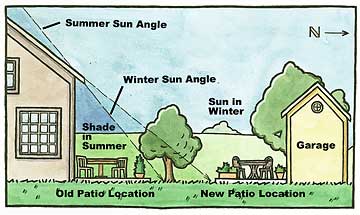Many factors influence how you should plan your home landscape. Some of the most important are ones you have very little control over. Use the checklists below to evaluate your yard's climate conditions and general terrain.
Live in a water-challenged landscape? Find tips for gardening in Utah and Arizona.
continue reading below
Rain, snow, & drainage
- Rain. As the main source of water for plants, rain is vital to their survival. Contact your county extension service or a local weather service to determine the average annual amount of precipitation in your area. It's also important to know when your area is typically wet and dry.You want to be prepared to provide supplemental watering.
- Snow Snowfall. contributes to soil moisture. A heavy blanket of snow insulates soil and can keep it warmer.
- Surface drainage. It's important to know what happens when rain falls in your yard. It may seem silly, but the best way to do this is to walk around the yard the next time there's a heavy rain and watch how the water moves. Note what happens around gutter downspouts, ditches, and any low spots.
- Soil drainage. Soil's ability to allow water to percolate through is essential to good drainage. After a heavy rain, note any areas where water puddles or soil remains soggy for some time.
- Irrigation. Note the location of irrigation lines, heads, and spigots.
Sun & shade
- Sunlight. Note the number of hours of sun exposure received by each part of the property. An area receiving six hours of sun or more is in full sun. Anything less than that is shade.

Consider how the path of the sunchanges from season to season when planning for outdoor living areas.
- Shade. There are several degrees of shade, from light to dense. Light shade is the brightest; densely shaded areas receive little sun. An area of partial shade receives about four hours of sun per day, either directly or indirectly. On the base map, mark the areads of sun and shade along with the amount of sun each receives throughout the day, particularly in the afternoon. Repeat this procedure during each season and note the changing angles of sun (see illustration above).
Wind
- Summer breezes. The same sources you used to learn about annual rainfall can identify the prevailing wind directions in your area. Notice how existing plantings or structures work for or against channeling breezes where you want them to go.
- Winter wind. Blocking winter winds can reduce your fuel bills. Windbreaks, which double as privacy screens, can also minimize snowdrift development.
- Odors. Unpleasant odors that come from off-site need to be noted in conjunction with the wind patterns. This also applies to your own trash bins or compost pile.
- Noise. Consider noises you want to block or buffer.
Views
- Good views. Draw arrows toward appealing views from various spots in the yard. A view can be of an object in your own yard or your neighbor's, or of something on the horizon.
- Poor views. Do the same for unpleasant views. Consider seasonal changes.
- Views. from within Include what you see from inside the house as well.
Terrain
- High or low. It's more revealing to walk around the grounds and note high and low spots, as well as any steep or eroding areas, than to look at a drawing. Moisture and frost may settle in low areas. Elevated places will be exposed to winds.






 Consider how the path of the sunchanges from season to season when planning for outdoor living areas.
Consider how the path of the sunchanges from season to season when planning for outdoor living areas.